Archive for the ‘100 Species Challenge’ Category

The week shimmers past quickly, and my head can’t quite keep up. I’m still chronicling Wondercon (although I will probably never get around to writing about the best part, the dinners with friends), and working, and repeatedly remembering that I keep forgetting to do the taxes.
(File under: Things that Make Me Wince.)

The best part of the morning was the nature walk. We’d just been reading about native San Diego flora and fauna in a “shrublands guide” published (and available for free download) by the California Chaparral Institute, and it was exciting to walk our familiar scrubby trails and greet the bushes by name. Some of the trees we knew already, like the downright Seussian bottle-brush tree, which grows in yards all over the city, but I’ve never before seen it bleed. Ruby sap, glinting in the sun, seeping through scarred bark. One could almost hear the Ents weeping.
I love knowing the names of things. In a way, names are my favorite things of all: the way a name lets you know a thing (bush, tree, flower, bird, person). What used to be a haze of indeterminate bushes becomes manzanita, scrub oak, chamise, sagebrush, buckwheat, each with a voice of its own.

The kids are more interested in birds than bushes. We create a ruckus as we go, and most of the wild things scatter. Only the hummingbirds ignore us. They are the Hermias of the bird world: though they be but little, they are fierce.

Under one of the bushes in the top photo, Beanie found a sort of burrow: flattened grass, a litter of empty snail shells. What lunches there, we’d like to know?

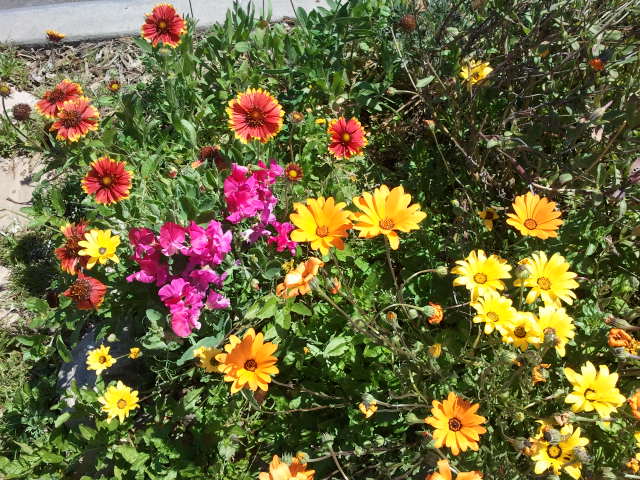
But these beauties had to be captured. Happened upon this patch of color springing up between sidewalk and street in Normal Heights, San Diego. Picture these flowers times four—a glorious strip of color.
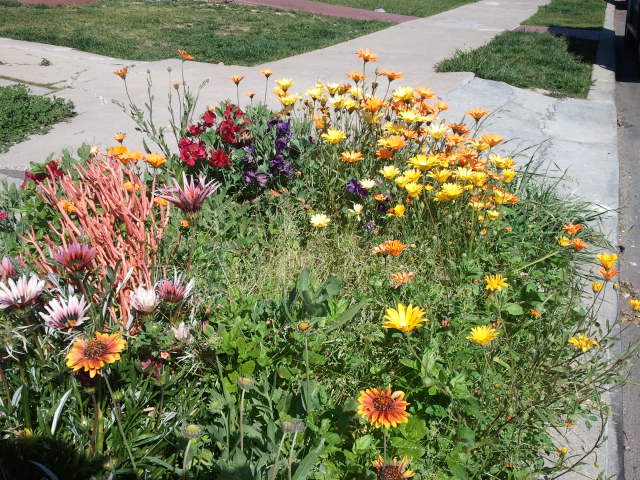
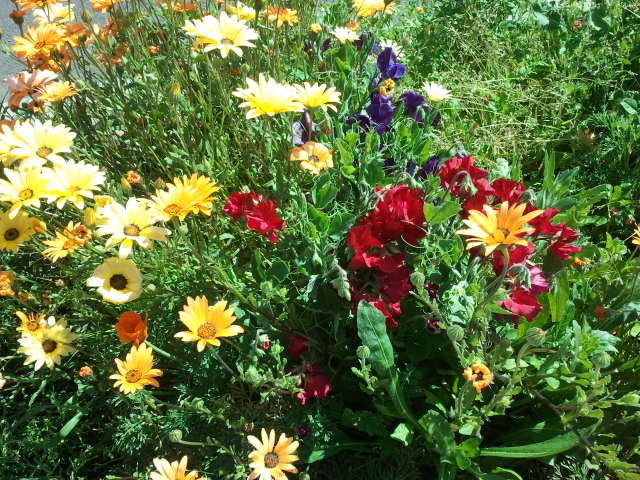
City gardeners, I adore you.
(I see gaillardia, snapdragon, and some kind of brown-eyed susan. Working on IDing the rest. The pink fringy ones in the middle photo look like a bit echinacea in the photo, but aren’t.)


Grape soda lupines (lupinus excubitus). These grow wild on the roadsides here, intermingled with the wild mustard (Father Serra was also here). Just gorgeous. They’re supposed to smell like their name, but we couldn’t catch the faintest whiff of grape.
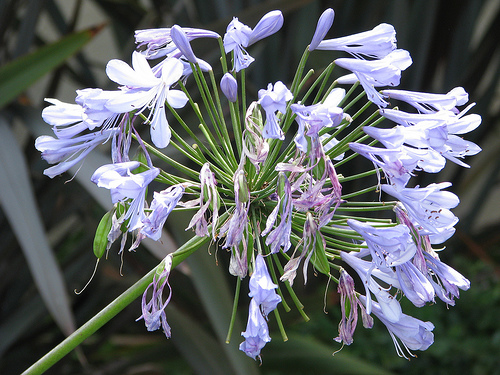
2. Agapanthus, or Lily of the Nile
Also called African lilies, these lovely shrubs grow in our front yard and all over town. Their bloom season is just passing now, so the globes of purple or white blossoms at the top of each long stalk are looking a little bedraggled these days. But all summer long they were gorgeous. You see them often in median plantings and commercial landscaping, often intermingled with the earlier-blooming bird-of-paradise flowers (that’ll be a future entry).

Lily of the Nile and red geraniums
3. Pelargonium
The red geraniums in the photo above give me a freebie for our challenge. Of course everybody knows what they are. Not that they are really geraniums—the correct name is pelargonium—but geranium is what everyone I’ve ever known has called them. On the east coast, we planted them as summer annuals or grew them in our windowsills. They’re still in my windows here, but they’re also in the ground, all over the place, sometimes in the form of huge bushes. I’ve adored them ever since Anne Shirley bestowed a kiss and a name (Bonny, of course!) on the red geranium blooming in Marilla’s kitchen.
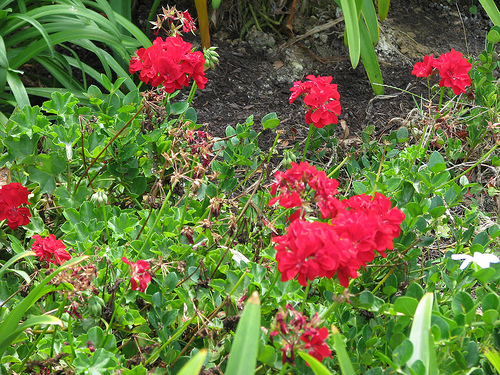
This entry has been added to our main 100 Species Challenge page which contains our list-in-progress.
Genevieve asked:
Okay.. maybe this is a silly question but how do go about learning about plants? We are surrounded by some beautifully landscaped areas but I have no clue how to start. The Peterson’s and Golden Guides are for “wild plants”. I seem to in the mood of firing off questions at your blog, Lissa. 
Not a silly question at all. Great question. I’m sure others will have lots of advice here, so please chime in, folks.
My best advice is to start with a good nursery in your area. Spend some time just browsing the aisles, especially looking out for plants you’ve seen in your neighborhood but don’t know the names of. When we moved here, that’s how I learned that the big, wide-leaved plants in our front yard with the spires of beautiful purple globes are agapanthus, or “lilies of the Nile.” We see them all over town, purple ones and white ones. (I snapped a photo yesterday for our Challenge, but haven’t uploaded it yet.)
You could even take some pictures to the nursery with you—on your cell phone or iPod perhaps—to show the knowledgeable workers there and ask for identification help.
Something I did in both New York and Virginia, but haven’t done here in California, was to make a visit to the local branch of the cooperative extension agency. This is a governmental organization funded by the Department of Agriculture. You can find the number in the blue pages of your phone book, or try the Cooperative Extension System website. This is a fantastic resource and almost everything there is free. You can take in a sample of your soil for testing to see how you might need to amend it for certain types of gardening. There will probably be lots of information—booklets, fliers, etc—about native plants, invasive plants, wildflowers, and such. We took home stacks of fliers from the Charlottesville, Virginia branch, I remember. There was also a lovely garden there of native plants, all clearly labeled (bring a camera when you visit!) and a how-to display on composting. And there were “Master Gardener” volunteers on hand to answer our plant- and bug-related questions!
Actually a trip to the county extension agency is a great field trip for anyone, would-be plant identifiers or not.
Another great resource is your local native plant society. This is something I usually look up within the first month of our living in a new place. In Virginia, the local NPS offered guided nature walks at a nearby preserve, as well as a perfectly wonderful annual sale of native plants grown by NPS members. If you saw my big butterflies post from a few years back, you heard me gushing about how awesome that plant sale was.
April, 2003
Yesterday I took Jane to a native plant sale at a nearby nature center while the other girls were napping. It took us forever to even get into the building where they had the plant sale, because there were a lot of booths set up for various nature clubs and societies, and she was fascinated by all of it. At every table she struck up a conversation with the people running the booth. The old lady at the Invasive Plant Display could not have been more delighted to have this little kid seeming so genuinely interested in how to avoid nasty invasives like multiflora rose and ailanthus tree. The lady gave us a really nice booklet with color photos, saying, “I don’t usually give these out to people, but you really seem to care!”
But the topper was the butterfly table…
Oh my gosh, 2003. Five years ago. That does not seem possible. Pardon me while I shed a nostalgic tear or two for Ivy Creek and the Saturday morning butterfly walks guided by the very same man I described meeting in that post.
:::sniff::: OK, I’m better now. We made that plant sale every year we lived in Virginia. I picked up some treasures there: a wood poppy, a spicebush, a hackberry tree. I have to stop now or I’ll get weepy again.
Here in San Diego, I joined the NPS email list immediately and receive regular notices of nature walks and other events. It’s also a good place to ask any questions I might have about a plants I’d like to identify. These groups are full of enthusiasts who are eager to help—and experience has taught me that most of the members tend to be older, retired folks who are thrilled to see some “young blood” (e.g. my children) showing an interest in their favorite topic. You can make wonderful friends this way.
And finally, I would recommend visiting local public gardens or nature centers. Most places will have sections of plantings with labels. We’ve learned a ton from visiting Mission Trails Regional Center, a vast expanse of hiking trails on the scrubby hills in East San Diego County. Not that my kids and I have spent much time on the trails themselves: it’s just not something I can manage with Rilla in the sling and Wonderboy in the stroller. But the visitor center at the main entrance is a treasure unto itself, and we’ve made several visits there. The grounds around the center are full of labeled plantings. In fact, item #1 on our 100 Species list (the only entry so far) was identified and photographed there.
Here are more posts I’ve written about visiting Mission Trails:
“Some Breezy Open Wherein it Seemeth Always Afternoon”
“At First I Could Only Hear People Sounds”
Busy Days
So, to recap:
• local nurseries
• cooperative extension agency
• native plant society
• nature centers and public gardens
And I’ll add:
• befriend a neighbor with a beautiful garden. Usually this kind of neighbor will spend a lot of time outside working in his or her yard, and if you stroll by with your children often enough, sooner or later you’re bound to strike up a conversation. There’s a nice old gentleman who lives next to an intersection on the edge of our neighborhood. We see him out tending his front yard, a mini-landscape of drought-tolerant plants, several times a week. He has a whimsical touch when it comes to landscaping, artfully incorporating suncatchers, pinwheels, bits of broken pottery and glass, and even some old sun-bleached bones into his plantings. He is always wearing an enormous straw hat. There’s a four-way stop at his corner, and my kids always wave when they see him. He grins and waves back. In the winter there’s a breathtaking row of tall poinsettias—really!—lining his driveway. In summer, sunflowers. One of these days I’m going to get up the nerve to pull over and tell him how much I enjoy driving by his garden. Maybe this winter he’ll let me take a picture of his poinsettias for our Challenge list, too. I’ll bet he could rattle off a hundred species in no time…
Anyone care to add to this list? How do you learn about plants in your neighborhood?
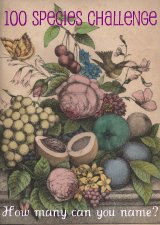 Here’s a list of bloggers who are participating in scsours‘s very cool 100 Species Challenge.
Here’s a list of bloggers who are participating in scsours‘s very cool 100 Species Challenge.
scsours, who started it all
The Bookworm (England)
Sandra Dodd (New Mexico)
The Common Room family
Monica (Romania)
Carmon at Buried Treasure
Learn-O-Rama (North Carolina)
Zoo on Wheels
applechexx
Yellow House Homeschool (Southeastern France)
Kathy at Restoration Place
Melanie at Wine-Dark Sea
Patricia at Wonderfarm (Northern California)
Ann of Holy Experience
Fiddler of Rockhound Place (New England)
MamaB at My Little Soapbox
JoVE’s family at Tricotmania
Angi at 4 Is Crazy
MacBeth (Long Island)
Love2Learn Mom (Wisconsin)
Ivy at Spinning Lovely Days
Theresa in Alaska said she might participate. I hope she does! Alaska! And several other commenters have said they might join in. I’ll add those links as they come.
Here’s my family’s running list for San Diego. I’ll post new entries as new posts and then add the info to the running list. We already have a bunch more plants to enter.
If you’d like to be added to this list, leave a link in the comments! (And if you’re not a blogger but want to share your family’s list, let me know. I can put you in your own post. 🙂 ) And if you’re on the list above and would like me to add your location, leave a comment for that too. I think it’s even more fun if we know the general whereabouts of people’s lists.
Don’t know what the 100 Species Challenge is? This post explains.
Updated to add this link to our family’s running list.
 At The Common Room I learned about the 100 Species Challenge, the brainchild of scsours over at xanga. The idea, sparked by a quote about how few people can name a hundred plant species in their own neighborhood, is to become the exception to that observation by learning to identify the flora of your own surroundings.
At The Common Room I learned about the 100 Species Challenge, the brainchild of scsours over at xanga. The idea, sparked by a quote about how few people can name a hundred plant species in their own neighborhood, is to become the exception to that observation by learning to identify the flora of your own surroundings.
Back in Virginia, we could have filled up our list right quick! But here in San Diego, as I’ve mentioned before, a good many of the plants are new to us. No longer can I dazzle my family with my encyclopedic horticultural knowledge. Nowadays, our jaunts around town are full of conversations along these lines:
Scott: “Ooh, pretty flowers. What are those called?”
Me: “I have no idea.”
Scott, incredulous: “But…but…but that’s your job!”
Which means, I guess, that all the other stuff I do around here is just a hobby. 😉
(Melissa Wiley: changes diapers for fun.)
Anyway. The 100 Species Challenge sounds like just what I need to regain my former lofty position as Family Guru of Flora and Fauna. (I’m thinking we’ll add fauna to our challenge: a second hundred-species list.)
Here are the rules:
1. Participants should include a copy of these rules and a link to this entry in their initial blog post about the challenge. I will make a sidebar list of anyone who notifies me that they are participating in the Challenge.
2. Participants should keep a list of all plant species they can name, either by common or scientific name, that are living within walking distance of the participant’s home. The list should be numbered, and should appear in every blog entry about the challenge, or in a sidebar.
3. Participants are encouraged to give detailed information about the plants they can name in the first post in which that plant appears. My format will be as follows: the numbered list, with plants making their first appearance on the list in bold; each plant making its first appearance will then have a photograph taken by me, where possible, a list of information I already knew about the plant, and a list of information I learned subsequent to starting this challenge, and a list of information I’d like to know. (See below for an example.) This format is not obligatory, however, and participants can adapt this portion of the challenge to their needs and desires.
4. Participants are encouraged to make it possible for visitors to their blog to find easily all 100-Species-Challenge blog posts. This can be done either by tagging these posts, by ending every post on the challenge with a link to your previous post on the challenge, or by some method which surpasses my technological ability and creativity.
5. Participants may post pictures of plants they are unable to identify, or are unable to identify with precision. They should not include these plants in the numbered list until they are able to identify it with relative precision. Each participant shall determine the level of precision that is acceptable to her; however, being able to distinguish between plants that have different common names should be a bare minimum.
6. Different varieties of the same species shall not count as different entries (e.g., Celebrity Tomato and Roma Tomato should not be separate entries); however, different species which share a common name be separate if the participant is able to distinguish between them (e.g., camillia japonica and camillia sassanqua if the participant can distinguish the two–“camillia” if not).
7. Participants may take as long as they like to complete the challenge. You can make it as quick or as detailed a project as you like. I’m planning to blog a minimum of two plants per week, complete with pictures and descriptions as below, which could take me up to a year. But you can do it in whatever level of detail you like.
I will probably create a separate page for our running lists: link to come.* The kids can help me keep it updated. It’s going to be fun to see how many we know right off the bat. We really have already learned a great deal in our almost two years here. (Can you believe it has been almost two years?)
Okay, what this project needs now is a pretty little button.** I would pester Alice Cantrell for one of her beautiful watercolors but it’s her gardening season and she just might be a tad busy!
*No time like the present: here it is!
**I tried my hand at a few (and stuck one in up above). Other contributions welcome.
Updated to add: Here’s a Flickr page for our Challenge as well.














